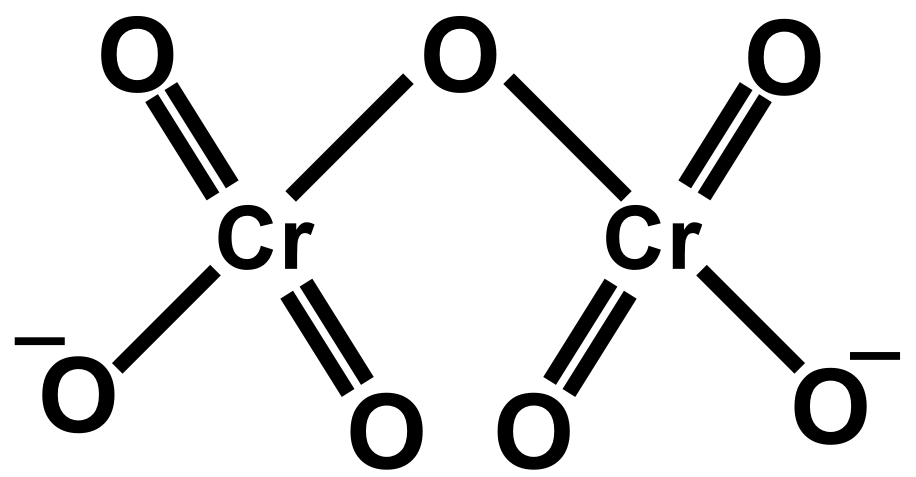
Which is the correct statement about $C{{r}_{2}}O_{7}^{2-}$ structure?
A.It has neither $Cr-Cr$ bonds nor $O-O$ bonds.
B.It has one $Cr-Cr$ bond and six $O-O$ bonds.
C.It has no $Cr-Cr$ bonds and six $O-O$ bonds.
D.It has one $Cr-Cr$ bond and seven $Cr-O$ bonds.
Answer
398.7k+ views
Hint: We know that the Dichromate ion $\left( C{{r}_{2}}O_{7}^{2-} \right)$ is an anionic part of its salt. Dichromate ion is one of the divalent inorganic anions. These are oxyanions having \[+6\] oxidation state of Chromium. These are very good oxidizing agents due to the attachment of oxygen atoms.
Complete answer:
As we know the concept of chemical bonding and structures of ions. Also, the bond length is defined as the equilibrium distance between the nuclei of two bonded atoms in a molecule. Bond lengths are expressed in terms of Angstrom or picometer. The two $Cr-O$ bonds which share the single oxygen atom are longer than the six $Cr-O$ terminal bonds that are equivalent. The salt of the dichromate ion is used for oxidation and reduction reactions. Dichromate poses an orange colour. The dichromate dianion consists of two tetrahedra sharing oxygen at the common corner.

In dichromate dianion structure the negative charge can be on any oxygen attached to $Cr$ thus all the $Cr-O$ are equivalent and since one $Cr-O-Cr$ bond. Dichromate is a divalent inorganic anion obtained by removal of both protons from dichromic acid. It is a chromium oxoanion and a divalent inorganic anion. It is a conjugate base of a hydrogen dichromate.
Therefore, the correct answer is option D.
Note:
Remember that the resonance is a way of describing delocalized electrons within certain molecules or polyatomic ions where the bonding cannot be expressed by a single Lewis formula. A molecule or ion with such delocalized electrons is represented by several resonance structures.
Complete answer:
As we know the concept of chemical bonding and structures of ions. Also, the bond length is defined as the equilibrium distance between the nuclei of two bonded atoms in a molecule. Bond lengths are expressed in terms of Angstrom or picometer. The two $Cr-O$ bonds which share the single oxygen atom are longer than the six $Cr-O$ terminal bonds that are equivalent. The salt of the dichromate ion is used for oxidation and reduction reactions. Dichromate poses an orange colour. The dichromate dianion consists of two tetrahedra sharing oxygen at the common corner.

In dichromate dianion structure the negative charge can be on any oxygen attached to $Cr$ thus all the $Cr-O$ are equivalent and since one $Cr-O-Cr$ bond. Dichromate is a divalent inorganic anion obtained by removal of both protons from dichromic acid. It is a chromium oxoanion and a divalent inorganic anion. It is a conjugate base of a hydrogen dichromate.
Therefore, the correct answer is option D.
Note:
Remember that the resonance is a way of describing delocalized electrons within certain molecules or polyatomic ions where the bonding cannot be expressed by a single Lewis formula. A molecule or ion with such delocalized electrons is represented by several resonance structures.
Recently Updated Pages
Master Class 12 Economics: Engaging Questions & Answers for Success

Master Class 12 Maths: Engaging Questions & Answers for Success

Master Class 12 Biology: Engaging Questions & Answers for Success

Master Class 12 Physics: Engaging Questions & Answers for Success

Master Class 12 Business Studies: Engaging Questions & Answers for Success

Master Class 12 English: Engaging Questions & Answers for Success

Trending doubts
What is the Full Form of PVC, PET, HDPE, LDPE, PP and PS ?

What are the major means of transport Explain each class 12 social science CBSE

Draw a neat and well labeled diagram of TS of ovary class 12 biology CBSE

When was the first election held in India a 194748 class 12 sst CBSE

What is pseudocoelom Where is it located class 12 biology CBSE

State the postulates of special theory of relativi class 12 physics CBSE




